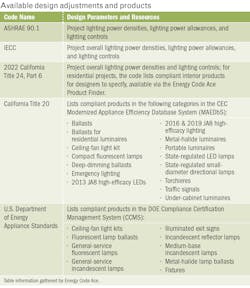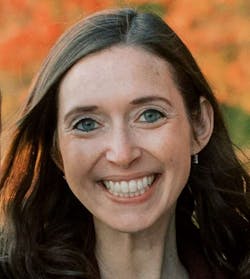Energy codes don’t dictate design. Contrary to popular belief, designers can use codes to their advantage by delivering efficient outcomes to their clients. They just need to know how. This article explains nuances of national and California codes, including ASHRAE 90.1, IECC, California’s Title 24, Part 6 and Title 20, and federal appliance regulations — and how to leverage this knowledge to support both designers’ vision and compliance. Lighting designers and architects will understand the intersection between energy codes and design, ways to modify designs for compliance, the tools and resources available, and how the requirements can benefit their customers. An increased understanding of codes enables greater flexibility in a lighting design.
Introduction
Building energy codes and state and federal appliance standards evolve continually to help reduce carbon emissions and fight climate change by placing a premium on energy efficiency and sustainability. National model codes are often developed by volunteer experts, while California energy efficiency codes and standards are established by the California Energy Commission. Both development processes incorporate input from myriad stakeholders, such as energy efficiency advocates and the building industry.
Because codes are crafted around the best existing and emerging technologies in the United States, they change frequently. While the environmental impact of these changes is positive, the influx of new requirements can leave designers feeling confused, overwhelmed, and limited. But codes and standards need not curb design; the market offers a variety of efficient design and product options, and manufacturers are increasingly emphasizing efficiency in their product lines to meet market demand. We will summarize key energy code elements to demonstrate how national and California codes align with contemporary design trends.
Codes have major impacts
California’s 2022 Title 24, Part 6 lighting requirements alone are estimated to save 282.7 GWh of electricity and 73,751 metric tons of CO2 emissions for projects that are permitted in 2023 and beyond6. This is equivalent to the annual greenhouse emissions of 15,891 gas-powered vehicles or the annual carbon sequestered by 87,280 acres of U.S. forests7.
The article authors work on behalf of Energy Code Ace and its programs. Energy Code Ace offers no-cost tools, training, and resources to decode the requirements of Title 24, Part 6 and Title 20.
Understanding national and state codes
While national codes such as ASHRAE 90.1 and the International Energy Conservation Code (IECC) are designed to provide consistency across the industry, state adoption of these codes varies. For example, some states have adopted the current ASHRAE 90.1/IECC requirements (updated every three years), others are a few versions behind, and some haven’t implemented any version1. The Illuminating Engineering Society (IES) Lighting Library provides energy efficiency recommendations for lighting by jurisdiction.
Regardless of where their firm is based, a designer must follow the applicable codes in the jurisdiction where the project is based. In California, the California Energy Commission (CEC) adopts lighting requirements through the state’s Appliance Efficiency Regulations (Title 20) and Title 24, Part 6. Title 20 requires certain lighting products to meet efficiency requirements before being sold or offered for sale in the state. Title 24, Part 6 specifies the lighting power density, control requirements, and allowable lighting installations for all permitted work, including new construction and applicable alterations and additions. It also includes Joint Reference Appendix 8 (JA8), which outlines how these requirements apply to lighting projects in single-family homes, multifamily units, and hotel guest rooms.
Appreciating the intersection of codes and design
Good lighting designers consider the needs of the space and its occupants when determining light output, distribution/direction, color, and control. While energy codes may require high-efficacy lighting, low power densities, and precise controls, myriad compliant products and options exist, particularly with today’s LED technology. The incorporation of lighting control requirements for daylight harvesting, occupancy sensing controls, and zone controls exemplifies how more stringent codes can benefit design by supporting a tailored lighting experience for the occupant and energy-saving objectives. As a result, designers can utilize the performance approach to maximize functionality of accent and general lighting.
Codes account for different lighting design needs for different applications and establish exceptions. They reflect the three primary ways of lighting a space: ambient, accent, and task. For example, Title 24, Part 6 includes a distinction for accent lighting that is wired separately from general lighting. Designers may use the Area Category Method or Tailored Method (see below) to allow for power allotments for display, decorative, or accent lighting in interior applications, which is detailed in Title 24, Part 6, Section 140.6(b).
Code requirements are also intended to support the needs of occupants. Based on ongoing research on the relationship between wavelengths and circadian rhythm2–4, the CEC carefully considered the type of colored lighting products to be installed in residential applications. JA8-compliant products may not exceed color temperatures greater than 4000K and must adhere to restrictions for inseparable solid-state lighting (SSL) luminaires containing color for decorative purposes, such as colored tape lighting and colored corner lighting. Many custom LED board lighting products also fall under this category. Outside of California, the full spectrum of color lighting may be considered for a nonresidential project.
The Area Category Method (ACM) and Tailored Method
The ACM divides a building into primary function areas, each defined under occupancy type in Title 24, Part 6, Section 100.1. Calculate the allowed lighting power by multiplying the area of each function by the lighting power density for that function. Areas bounded or separated by interior partitions must include the floor space occupied by those interior partitions. The total allowed wattage is the summation of the allowed lighting power for each area covered by the permit application.
When using this method, designers must include each function area in the building as a separate area. Boundaries between primary function areas can be walls, partitions, or neither. For example, kitchen and dining areas within a fast-food restaurant may or may not be separated by walls. For compliance purposes, they are still considered two different function areas. Separating aisles or entries within primary function areas is not necessary. However, when calculating the allowed total lighting power for an entire building, designers must treat the main entry lobbies, corridors, restrooms, and support functions as separate function areas.
The Tailored Method is a lighting compliance approach that establishes an allowed lighting power budget on a room-by-room or area-by-area basis. This method can be helpful when more general lighting power is required for the listed primary function areas in Table 140.6-D and for the listed area that has a high room cavity ratio. In addition to providing a lighting power budget for general illumination, the Tailored Method provides lighting power budgets for illuminating wall displays, floor displays, task lighting, and ornamental/special effects lighting — informally referred to as “use-it-or-lose-it” lighting power allowances because they cannot be traded off to other areas or applications. If a design does not include these additional layers of lighting power, then the total lighting power budget using the Tailored Method may be less than that using the ACM.
Lighting design versus product adjustments
The table summarizes available codes with relevance to lighting design parameters. ASHRAE, the International Code Council (ICC), the U.S. Department of Energy (DOE), and the CEC actively try not to inhibit emerging technology as future codes are being developed.
ASHRAE 90.1, the IECC, and Title 24, Part 6 are updated on a three-year cycle; Title 20 is not updated on a set schedule. However, lighting requirements are not revised in every code cycle and the significance of the changes varies. For example, the 2019 version of Title 24, Part 6 standards established many lighting requirements that were retained in the 2022 version, which goes into effect Jan. 1, 2023. DOE is required to review each national appliance standard every six years and publish either a proposed rule to update the standard or a determination that no change is warranted.
Leveraging compliance support tools
In addition to finding products in the MAEDbS and DOE’s CCMS, the DesignLights Consortium (DLC) and Energy Star each offer a qualified product list for their respective voluntary efficiency and quality guidelines. The Energy Star database largely contains residential lighting products and ceiling fan light kits, while the DLC focuses on commercial technologies.
Energy Star products generally meet more stringent efficiency and quality requirements than federal and state standards (with California being an exception), so the program’s product finder is a good place to start finding products compatible with LPD and control requirements. For example, DOE recently adopted a standard that requires all A-lamps to be 45 lm/W. However, Energy Star A-lamps must be 70 to 80 lm/W (depending on the color rendering index).
For the tech savvy, Energy Star also offers data integration through an application programming interface (API) that may be useful in personal product database management.
Remembering wattage
While LEDs are more efficient than incumbent technologies, lighting designers and installers should consider the total wattage of their complete lighting installations. Not all LED fixtures and lamps are created equal and that holds true for efficacy. Don’t assume lamps and fixtures won’t impact the energy budget because they use LEDs. And while wattage of individual LED fixtures and lamps may seem low, their aggregate energy consumption can be surprisingly high. Similarly, just because you bought low-calorie chips doesn’t mean you should eat the whole bag. Consider how many fixtures and lamps — no matter their efficiency — are truly needed to adequately light a space.
Demonstrating benefits to clients
Considering the energy implications of a lighting design takes time, but the ultimate outcome can be strategically lit spaces with state-of-the-art
technology and controllability. Not only will clients enjoy LEDs’ long operating life and tunability, but they will also see savings on energy bills. Lighting energy codes can yield electricity savings and reduce greenhouse gas emissions statewide. Over the last few years, according to Deloitte’s #GetOutInFront research, the public has demonstrated its care for environmental, social, and cultural issues — and it will not settle for the status quo5.
A number of training courses and fact sheets are available. Users may submit questions directly to [email protected].
REFERENCES
1. To understand the status of state energy code adoption, see the Department of Energy’s Building Energy Codes maps (residential and commercial).
2. Lighting Research Center, Lighting for Healthy Living website.
3. C. Blume et al., “Effects of light on human circadian rhythms, sleep and mood,” Somnologie, 23(3): 147–156 (2019).
4. L.J. Kraus, “Human and environmental effects of light emitting diode (LED) community lighting,” Report of the Council on Science and Public Health, American Medical Association (2016).
5. Wall Street Journal, “Consumers expect brands to address climate change” (April 20, 2021).
6. California Energy Codes & Standards, 2022 Cycle Impacts information page.
7. U.S. Environmental Protection Agency, Greenhouse Gas Equivalencies Calculator (updated March 2022).
Get to know our experts
EILEEN EATON is a senior project manager at Energy Solutions serving on the Policy & Ratings Team. She acts as the measure lead for Energy Code Ace and specializes in stakeholder engagement with expertise in residential lighting, white goods, pools, and consumer electronics. Before joining Energy Solutions, she spent over 15 years working on the Consortium for Energy Efficiency (CEE) engaging with utilities and industry on residential market transformation programs. Specifically, Eaton acted as the liaison for the Energy Star program, managed the CEE Residential Lighting Initiative, and oversaw the Lighting for Tomorrow competition in partnership with the American Lighting Association and UL. She is skilled in strategic planning, facilitation, consensus building, industry engagement, stakeholder communication, technical research, and writing. Eaton holds a B.S. in environmental science from the University of Massachusetts at Amherst and MPA in environmental science and policy from Columbia University.
JASMINE SHEPARD is an engineer at Energy Solutions specializing in lighting codes and standards. She supports Energy Code Ace tool, training, and resource development. During the 2022 and 2019 Title 24, Part 6 code cycles, Shepard was a technical lead and co-author for the lighting proposals. Before joining Energy Solutions, she conducted energy audits and commissioning, including air leakage, combustion safety, and the acceptance testing of lighting controls. She has worked in the energy efficiency and renewable sectors for a decade, and holds a B.S. in electrical engineering technology from Georgia Southern and studied environmental controls technology at Laney College.
For up-to-the-minute LED and SSL updates, follow us on Twitter. You’ll find curated content and commentary, as well as information on industry events, webcasts, and surveys on our LinkedIn page and our Facebook page.








